
![]()

 For
generations the fate of the Counts
of Toulouse was intimately tied to that of the Kings
of England. This period saw the rise of Crusading fervour:
not only in the Holy Land, but also against Moorish Spain,
The Cathars of the Languedoc and anyone who regarded by
the papacy as an enemy of the Roman Catholic Church - which
included both Counts
of Toulouse and Kings of England. The family of de Montfort
also played a major part during this period, not only as
Crusaders, but as leaders of parties hostile to the Counts
of Toulouse and parties hostile to the kings of England.
For
generations the fate of the Counts
of Toulouse was intimately tied to that of the Kings
of England. This period saw the rise of Crusading fervour:
not only in the Holy Land, but also against Moorish Spain,
The Cathars of the Languedoc and anyone who regarded by
the papacy as an enemy of the Roman Catholic Church - which
included both Counts
of Toulouse and Kings of England. The family of de Montfort
also played a major part during this period, not only as
Crusaders, but as leaders of parties hostile to the Counts
of Toulouse and parties hostile to the kings of England.
 King
Henry II
King
Henry II
King
Richard I
King John
King
Henry III
Henry II (5 March 1133-6 July 1189), King of England (25 October 1154-6 July 1189), Duke of Normandy, Count of Anjou.

![]() Arranged
marriages were perfectly normal in the medieval Europe,
as they have continued to be for European royal families
until modern times. Daughters were often married off to
seal political alliances, and the pope could generally be
relied on to grant annulments on demand when circumstances
changed. (A long series of popes granted annulments for
a fee - for well over 20% of noble and royal marriages).
Arranged
marriages were perfectly normal in the medieval Europe,
as they have continued to be for European royal families
until modern times. Daughters were often married off to
seal political alliances, and the pope could generally be
relied on to grant annulments on demand when circumstances
changed. (A long series of popes granted annulments for
a fee - for well over 20% of noble and royal marriages).
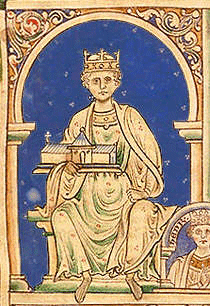
![]() When
Louis VII, King of France, married Eleanor
of Aquitaine. because she was heiress to the vast territories
of Poitou and the Aquitaine, no one was greatly surprised.
There was more surprise when the royal couple sought an
annulment in 1152, since the King thereby lost control of
the Aquitaine, a territory much larger than medieval France.
The mistake, which must have been glaring enough anyway,
was exacerbated when just two months later Eleanor
married the Count of Anjou, better known to us as Henry
II, King of England, and claimant to the French throne.
Henry and Eleanor
had seven children:
When
Louis VII, King of France, married Eleanor
of Aquitaine. because she was heiress to the vast territories
of Poitou and the Aquitaine, no one was greatly surprised.
There was more surprise when the royal couple sought an
annulment in 1152, since the King thereby lost control of
the Aquitaine, a territory much larger than medieval France.
The mistake, which must have been glaring enough anyway,
was exacerbated when just two months later Eleanor
married the Count of Anjou, better known to us as Henry
II, King of England, and claimant to the French throne.
Henry and Eleanor
had seven children:
- William, Count of Poitiers
- Henry ("Henry the Young King")
- Matilda of England,
- Richard (Richard I of England, The Lionheart
- Geoffrey II, Duke of Brittany
- Leonora of Aquitaine
- Jeanne of England
- John (King John of England)

One of the sons of Henry and Eleanor, Richard, later King Richard I, ruled the Aquitaine as Duke in conjunction with his mother. The Dukes of Aquitaine and the Counts of Toulouse were natural allies, between them controlling the area that we now think of as the southern half of France. The families were already related: Eleanor's paternal grandmother had been Philippa of Toulouse. Both families spoke the same language, Occitan, the first language not only of Raymond and Eleanor, but also of Eleanor's heir, Richard. They followed the same fashions, ate the same food, read the same literature, even listened to the same troubadours, and were familiar with distinctive Occitan concepts such as paratge. It was natural then, that Raymond VI, Count of Toulouse, should marry Jeanne of England, daughter of Henry and Eleanor. This marriage made him son-in-law of Henry II and Eleanor, and brother-in-law to both Richard I (the Lionheart) and King John. He is buried at Fontevraud Abbey.
Richard I, Coeur de Lion, Richard the Lionheart, (8 September 1157 – 6 April 1199) King of England (6 July 1189 – 6 April 1199), Duke of Aquitaine, Duke of Normandy, Count of the Anjou.
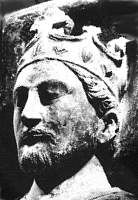

![]()
![]() Richard
was brought up to be Duke
of Aquitaine, not King of England (He had an older brother
called Henry who was expected to succeeded to the kingdom,
and who was actually crowned during the lifetime of his
father Henry II,
but never reigned. Richard stood to inherit the crown of
England only when the "Young King Henry" died
during the lifetime of Henry
II). It could be fairly said that Richard considered
himself first as Duke
of Aquitaine, second as a Crusader and third as King
of England. Many English historians who fail to grasp this
are surprised and disappointed by the fact that he spent
only six months of his ten year reign in England; and mystified
by the fact that he regarded England as little more than
a milch cow (he once commented that he would sell London
if he could).
Richard
was brought up to be Duke
of Aquitaine, not King of England (He had an older brother
called Henry who was expected to succeeded to the kingdom,
and who was actually crowned during the lifetime of his
father Henry II,
but never reigned. Richard stood to inherit the crown of
England only when the "Young King Henry" died
during the lifetime of Henry
II). It could be fairly said that Richard considered
himself first as Duke
of Aquitaine, second as a Crusader and third as King
of England. Many English historians who fail to grasp this
are surprised and disappointed by the fact that he spent
only six months of his ten year reign in England; and mystified
by the fact that he regarded England as little more than
a milch cow (he once commented that he would sell London
if he could).
|
For generations the Dukes of Aquitaine had claimed suzerainity over the Counts of Toulouse. This was a point of discord with unfortunate consequences. For example Languedoc wines could not easily be exported to England as long as Aquitaine remained hostile. Again, if on his return from Crusading Richard had been able to land at one of the Mediterranean Ports controlled by the Counts of Toulouse, he would not have had to take a dangerous overland route through Europe. It was precisely because he did have to take such a route that he finished up in an Austrian prison.
Some of the towns belonging to the counts of Toulouse had been founded by Richard I. One such was Marmande, a bastide founded about 1195, which was later besieged three times during the Cathar Crusades - a series of religious wars directed against the counts of Toulouse and the people of the Languedoc. |
|
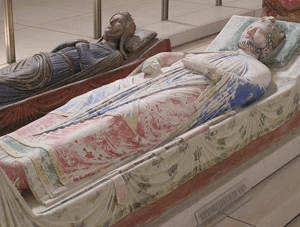
![]() Jeanne
of England was Raymond's second wife. He had six wives
altogether. The fifth was a daughter of Isaac Comnenus of
Cyprus, possibly called Beatrice. She had been taken from
her father by King
Richard I when he took Cyprus while on Crusade to the
Holy Land. She had become the companion of Richard's wife
Berengaria and his sister, Jeanne
of England, Raymond VI's earlier wife.
Jeanne
of England was Raymond's second wife. He had six wives
altogether. The fifth was a daughter of Isaac Comnenus of
Cyprus, possibly called Beatrice. She had been taken from
her father by King
Richard I when he took Cyprus while on Crusade to the
Holy Land. She had become the companion of Richard's wife
Berengaria and his sister, Jeanne
of England, Raymond VI's earlier wife.
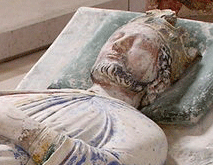
![]() In
death, as in life, the three great houses Toulouse, Aquitaine
and England were linked together. The Pope denied Raymond VI of Toulouse a Catholic burial,
but Raymond
VII of Toulouse was interred in the Abbey of Fontevraud,
along with his grandmother, Eleanor
of Aquitaine, his mother Jeanne
of England and Richard his plantagenet uncle.
In
death, as in life, the three great houses Toulouse, Aquitaine
and England were linked together. The Pope denied Raymond VI of Toulouse a Catholic burial,
but Raymond
VII of Toulouse was interred in the Abbey of Fontevraud,
along with his grandmother, Eleanor
of Aquitaine, his mother Jeanne
of England and Richard his plantagenet uncle.
John (24 December c. 1166 – 18 October 1216) , King of England (6 April 1199 — 18 October 1216), Lord of Ireland, Duke of Normandy and Aquitaine and Count of Anjou.
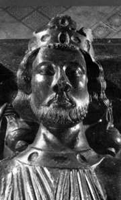

![]()
![]() John's
second marriage (on 24 August 1200) was to Isabella of Angoulême,
the daughter of Aymer Taillefer, Count of Angouleme - another
Occitan paladin.
John's
second marriage (on 24 August 1200) was to Isabella of Angoulême,
the daughter of Aymer Taillefer, Count of Angouleme - another
Occitan paladin.
Raymond VI of Toulouse naturally chose exile in England when his lands were seized by the French Crusaders - Despite his avaricious nature, King John made Raymond a subvention of 10,000 marks.
Like the Counts of Toulouse, John was the victim of Innocent III's imperial ambitions. In the case of the Counts of Toulouse their territories were appropriated and reassigned by papal decree, a worrying innovation for all sovereigns in western Christendom. In similar danger, John took the hint and ceded his kingdom, receiving it back as a vassal of Innocent.
John was a spectacularly bad king. He created much animosity by seizing the property of his own nobles - wives and daughters as well as lands and castles. One of his victims was Simon IV de Montfort who was deprived of his lawful claim to the earldom of Leicester. His lack of substantial estates at east partially accounted for him being appointed to lead the Albigensian Crusade after the massacre at Béziers and the siege of Carcassonne in 1209 (If one of the great dukes of France had accepted the appointment they might easily have seen by the French king to be too ambitious).
John lost a large portion of his continental territories through incompetence and lethargy - one of his nicknames was soft-sword. Widely hated, his own barons appealed to the King of France, who offered his son Louis (Later King Louis VIII of France) as a potential replacement monarch. In 1216 many Crusaders took time off from their crusades in the Holy Land or in the Languedoc to assist in the enterprise of displacing King John from the English throne. This explains why so so many French Crusaders were found fighting in England in 1216. Louis' attempt had every prospect of succeeding when John died unexpectedly. The incomparable William Marshal stepped in on behalf of John's son and heir, the infant Henry III. The English barons rallied behind him, and after a couple of severe batterings the French knights returned to France, to the Levant or to the Languedoc to resume their longer term programmes of killing there.
Henry III (1 October 1207 – 16 November 1272), King of England (18 October 1216 - 16 November 1272), Lord of Ireland and Duke of Aquitaine
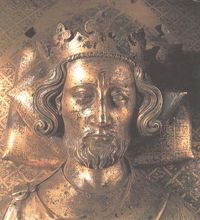


 Henry
III of England married Eleanor of Provence, daughter of
the Count of Provence, establishing further links between
the English crown and Occitania. Henry was first cousin
to Raymond
VII of Toulouse, and took part in an abortive attack
in support of the last attempt by the forces loyal to the
Counts
of Toulouse to expel the French invaders in 1242. Henry
was defeated at Tailebourg and the only significant achievement
of Raymond's forces was the killing of a party of Inquisition
at Avignonet.
Henry
III of England married Eleanor of Provence, daughter of
the Count of Provence, establishing further links between
the English crown and Occitania. Henry was first cousin
to Raymond
VII of Toulouse, and took part in an abortive attack
in support of the last attempt by the forces loyal to the
Counts
of Toulouse to expel the French invaders in 1242. Henry
was defeated at Tailebourg and the only significant achievement
of Raymond's forces was the killing of a party of Inquisition
at Avignonet.
|
Henry's reign was marked by civil strife. The English barons, led by Simon de Montfort, Earl of Leicester, demanded more say in the running of the kingdom. This Simon was the Son of Simon IV de Montfort the leader of the Albigensian Crusade against the people of the Languedoc. The French-born younger Simon had been one of the foreign upstarts loathed by many native English barons, but he gradually came to lead many of these same barons. After he married Henry’s sister (another Eleanor) without consulting Henry he became the king's enemy. Their relationship reached a crisis in the 1250s when Simon was arraigned on charges for actions he had taken as lieutenant of Gascony, the last remaining Plantagenet land on the Continent of Europe. To the King's evident displeasure Simon was acquitted by his peers, the barons. Many barons feared that Henry was taking after his
authoritarian father, King
John. Simon de Montfort now became leader of the
barons who wanted to reassert and reissue Magna Carta.
In 1258, seven leading barons obliged Henry to agree
to the Provisions of Oxford, which abrogated absolutist
monarchy, gave executive power to a council of fifteen
barons, and provided for a three-yearly meeting of
parliament to oversee this new Executive. Henry was
forced to take part in the swearing of a collective
oath accepting the Provisions of Oxford. In the following
years, the party supporting Simon de Montfort and
the party supporting Henry grew yet more polarised.
Henry obtained a papal bull in 1262 excusing him from
his oath. Both sides now began to raise armies. A
civil war, known as the Second Barons' War,
soon followed. Simon de Montfort and his forces captured
most of south-eastern England by 1263. On 14 May 1264,
at the Battle of Lewes, the king was defeated and
taken prisoner. Henry was reduced to a figurehead,
and he and his son Edward (Longshanks) lived under
house arrest. Simon meanwhile broadened parliamentary
representation to include each county of England as
well as important towns. This was in effect the birth
of representative democracy in England - an embryonic
House of Commons. Edward Longshanks subsequently escaped
captivity and led the royalists to defeat de Montfort
at the Battle of Evesham in 1265. Retribution was
exacted on the rebels, but absolutist monarchy was
abandoned for ever in favour of a representative democratic
monarchy which has evolved into the modern British
democratic system. |
|
|













